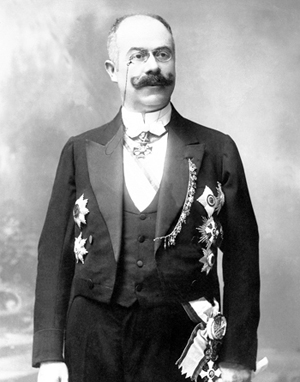
Emil Jellinek, known after 1903 as Emil Jellinek Mercedes (6 April 1853 – 21 January 1918) was a wealthy European entrepreneur who sat on the board of Daimler-Motoren-Gesellschaft (‘DMG’) between 1900 and 1909. He specified an engine designed there by Wilhelm Maybach and Gottlieb Daimler for the first ‘modern’ car. Jellinek required naming the brand after his daughter, Mercedes Jellinek.
Emil Jellinek was a young man who enjoyed a fashionable lifestyle when the automobile was invented in 1886. He was fascinated with the new product and owned one ever since they appeared: after first trying out a De Dion three-wheeler he bought a four-wheeled Benz Viktoria when the model became available in 1893. But he was not really satisfied yet with the new vehicles. In his view they could be better and had not developed their full potential. He referred to the Benz, for example, as a “monster”, comparing it with a crawling spider. Eventually, in 1896 a newspaper advertisement of Daimler-Motoren-Gesellschaft (DMG) caught Jellinek’s attention. He travelled to Cannstatt and ordered two belt-driven cars, “a four-horsepower and a nine-horsepower” which were said to do 40 km/h on a “smooth road” – an unheard-of speed in the outgoing nineteenth century.
In Nice, where Emil Jellinek spent most of the year, and which was then a meeting place for the upper crust of France and Europe mainly in the winter, the horseless carriages caught on very well. Starting in 1897 Jellinek promoted the Daimler automobiles in the highest social circles, working as an independent dealer. The Rothschild family and other well-known personalities bought cars from him. By the time Gottlieb Daimler passed away in 1900, Jellinek had managed to sell 34 cars this way. This gave him weight in his dealings with DMG, and he repeatedly demanded technical innovations of Daimler and engineer Wilhelm Maybach. He combined an ability to judge vehicles with an antenna for the market, and, viewed on the whole, definitely can be described as a marketing strategist.
Jellinek finally convinced Daimler and Maybach that the future of the automobile lay in speed and elegance. “When I came on the scene the Daimler cars were solid, usable and reliable in service, but only cars in theory” he is quoted as saying. But he did not see speed as a temptation to be imprudent, rather he considered it the real purpose of a motor vehicle: “If I can’t get any more out of an automobile than out of a horse and carriage, then I might as well travel by horse again!” Moreover, he suggested that the inventor of the automobile compete in races and reliability runs under his own name and with his own cars, because “racing will make a name for a factory and a brand.”
The birth of the Mercedes brand
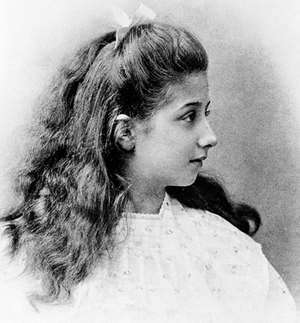
Jellinek took a hand in racing himself. For a racing event in Nice in 1899 he had two Daimler Phoenix cars built for himself. They had an output of 21 kW – a great deal for that period. The vehicles could pass for sports cars or racing cars. To support him, DMG sent him Wilhelm Bauer, a foreman who was most familiar with the Phoenix model.
This race is regarded as the birth of the Mercedes brand. As the story about the origin of the name commonly goes, Jellinek took part under the pseudonym “Monsieur Mercédès” – this was a normal way for race participants to conceal their identity in those days. Mercedes was the name of his daughter which “has a nice Spanish ring to it. Spain holds a place of honour among my father’s fancies,” Guy Jellinek-Mercedes relates. “He has a good command of the language and likes to speak it.”
However, the cars from the Daimler company were not good enough to win either the speed trials or the hillclimb. This spurred Jellinek on: he strongly interfered in the company’s model policy, demanding more powerful, faster vehicles from DMG. In addition, he wanted a new chassis: wider, longer, lower-slung, lighter – in short: safer than before, even at higher speeds. “I am not interested in today’s car or tomorrow’s – I want the car of the day after tomorrow!” This was Emil Jellinek’s maxim. “My workshop is the road. Only the road is the criterion for me.”
During the Nice racing week at the end of March 1900, disaster struck. In the Nice – La Turbie mountain race Daimler factory driver Wilhelm Bauer suffered a fatal accident with the car entered in the race as “Mercédès II”. Co-driver Hermann Braun, who already overturned in the Nice – Marseille race with “Mercédès I”, the second Daimler entered at the race week, again remain unscathed. Cannstatt’s first reaction was to make excessive engine outputs responsible for the accident and to stay away from any speed events in future.
However, Emil Jellinek convinced Wilhelm Maybach in early March – that the car’s high centre of gravity was responsible for the accident: “Victories bring world fame. People buy the winning brand, and will always buy it. It would be commercial suicide to abstain from racing,” Jellinek argued. “What we need is a new vehicle of completely different design.”
DMG yielded to Jellinek’s urging, and on 2 April 1900 Jellinek ordered the development of a new kind of car: it was to have an output of at least 26 kW, a lightweight engine, a lower centre of gravity – in short, it had to be light, well-proportioned and fast. Jellinek proposed that the new model series be named “Daimler-Mercedes”, and so in 1900 “Mercedes” appeared for the first time as a brand name in its own right and not as a designation for an individual car or driver.
DMG was confronted with the problem of sales financing, however. The company needed further capital: even assuming it would be a success, whether or not the cars actually would be sold still posed a relatively high risk. On ordering the fast, handsome vehicles, Emil Jellinek proposed that he take a fixed number at ex works price and share the sales profit with DMG. The company agreed: on 2 April 1900 the dealer and the manufacturer concluded an agreement on the sale of cars and engines “providing that the sale of the engines under the name Daimler-Mercedes be handled by Jellinek,” as a 1915 commemorative volume states. The dealer committed himself to take a complete series of 36 cars for a total price of 550,000 marks (today’s standards in 2005, would have been equivalent to 2.3 million euros) and was to see to it that the press in France, Germany and Austria reported on the new vehicle. On top of that he was voted onto the DMG supervisory board in October 1900.
The agreement also assured him far-reaching sales rights for more powerful cars from DMG in all major markets. From April 1900 Emil Jellinek was thus general distributor for Austria-Hungary, France, Belgium and the USA – “practically for the whole world,” as one chronicler writes. Jellinek himself was a citizen of Austria-Hungary. In the countries where he was sole distributor, the cars were sold under name “Mercedes”, while in all other countries they initially sold as “new Daimler”. But soon people in all countries only talked about “Mercedes cars”.
“We have entered the Mercedes era”!
The first new 35 hp car was delivered to Jellinek on 22 December 1900. This new “Mercedes” developed by Wilhelm Maybach caused a sensation at the start of the century: it was the world’s first modern car. One of its numerous technical innovations was the honeycomb radiator, which needed far less water than before to cool the engine. As to the name change to Mercedes, Jellinek is quoted as having said this in 1906: “For non-Germans the good old name Daimler was hard to digest. But a name sometimes means everything. It must be easy to pronounce for any tongue, must be catchy and stick in people’s mind.”
Jellinek at any rate was very good at promoting the new type of automobile. As early as 4 January 1901, just a few days after the arrival of the first Mercedes in Nice, the L’Automobile-Revue du Littoral published an article which stated: “There is nothing new to see in Paris right now – but in Nice. The first Mercedes car built in the workshops of Cannstatt has arrived in Nice, and thanks to the cooperativeness of its owner, Mr. Jellinek, all car drivers were able to have a close look at it. We make no secret of our opinion: the Mercedes car is very, very interesting. This remarkable vehicle will be a fearsome competitor in the races of 1901.”
At the Nice racing week in late March 1901 the cars with the name Mercedes demonstrated to a large audience just what they were capable of: with four first-place and five second-place finishes the Daimler cars were in a class of their own – both in the long-distance run, the hillclimb and the mile race. The French manufacturer Panhard & Levassor, who had captured first place in all races of the previous year, withdrew its vehicles before the start.
“We were victorious all down the line: the Mercedes car has been launched. Mercedes was the car of the day,” Emil Jellinek said for the record. Paul Meyan, general secretary of the French Automobile Club, coined the phrase: “We have entered the Mercedes era!” For until then, although the Germans Carl Benz and Gottlieb Daimler were regarded as the inventors of the automobile, the French were considered the better carmakers. The cream of society was enthusiastic about the new vehicle. In 1901 the American billionaires Rockefeller, Astor, Morgan and Taylor were among the buyers of the powerful Mercedes cars of DMG. Wilhelm Maybach, of whom Jellinek was convinced that he could “invent on command”, and who was celebrated by the French as the king of constructors, developed the new method of building automobiles further. But Maybach shared the kudos with Jellinek: “You and I are the inventors of the Mercedes car,” he wrote later on in a letter.
Dynamic demand for a very fast car
As the engine power and speed increased, so too did production and sales. In 1903, 232 units of the improved model series of the Mercedes-Simplex already were manufactured; the number was 698 the next year, and even 863 in 1905. Owing to the successes on the racetrack production was sold out until 1904. In 1904 Emil Jellinek set a new sales record for Mercedes with 24 orders from Belgium, 12 from the Netherlands, and 150 from Britain. Around a hundred years later.
In the wake of the success of the Mercedes cars, Jellinek constantly tormented the company management with suggestions for improvements and complaints, to the effect that the company should not rest on its laurels but make the magnificent cars even better. “From now on I am not accepting any car whose gearing is not completely noiseless,” he wrote for example on 25 August 1904. “It has been effectively found that DMG gearboxes currently are the noisiest of all makes and that even cars of much lower quality run more quietly than ours.” The relationship between Jellinek and the management in Cannstatt accordingly was tense: “My father can get along with Vischer if necessary, he tolerates Duttenhofer as well as he can, but he does not like Lorenz at all,” Guy Jellinek-Mercedes writes in his father’s biography.
This automotive visionary was apt to jot down his countless ideas on the white cuffs of his shirts: “So he changed shirts three times a day, and his secretary then transferred his notes to paper and sent them to Mercedes engineer Wilhelm Maybach,” as his daughter Andrée Jellinek-Mercedes remembers. “He then put father’s ideas into practice.” Letter post apparently also was too slow for him, he preferred telegraph – and kept his entire family and his domestic servants on the go all the time.
The tone of his suggestions for improvements and his complaints became increasingly rude over the years. The DMG management board members quickly were offended and wanted to reintroduce “Daimler” as brand name for the further improved cars starting in 1902, because: “We thought this would also be in your interest considering the many complaints you have raised about the Mercedes models,” as noted in a letter from the board. But in the end it was agreed to retain the now widely known brand name and use it from then on everywhere in the world. In 1902 all passenger cars from the Daimler company were called Mercedes; the trademark was officially protected on 23 June 1902.
When a large part of the Daimler factory in Cannstatt went up in flames on 10 June 1903, Jellinek again became active: as the three 90 hp Mercedes for the Gordon Bennett Race also had been lost to the fire, he started thinking about who could make a car available to him for the event, and the type of car it should be: a 60 hp model would be best since they had made a good showing in all previous races. He found one owned by the American Gray Dinsmore. The Belgian racing driver Camille Jenatzy piloted the car to victory in the race, which was held in Ireland. With that a German car entered its name in the list of winners for the first time – and Germany gained the honour of staging the race, which enjoyed an international reputation comparable with today’s Formula One events, in 1904.
Prestige and self-confidence
“His partly very eccentric views and habits permitted him to recognise at an early point in time the economic opportunities afforded by this relatively new invention – initially he found the automobile exciting from a user’s standpoint,” writes Klaus Kempter describing the clever businessman Emil Jellinek in a comprehensive family biography entitled, Die Jellineks 1820-1955. Indeed, as time went on the new line of business made the wealthy merchant a multimillionaire. In the course of the years he turned his “Villa Mercedes” in Baden, near Vienna, where he usually spent much of the summer, into a palace with almost 50 rooms and halls. His winter residence, “Villa Mercédès” in Nice, is also an impressive structure situated on famed Promenade des Anglais, house number 54, with a view of the Mediterranean.
The self-made millionaire obviously was very self-confident and prestige-minded, proud to have access to Europe’s higher nobility and financial aristocracy and thus to the more exclusive circles in Nice. He thought titles and medals were very stylish. When he was granted the right in Austria in 1903 to append the now famous trademark Mercedes to his family name, he considered this a kind of patent of nobility. From then on his name was Emil Jellinek-Mercedes, and he is said to have commented on this with the words: “Perhaps for the first time a father is known by the name of his daughter.” In 1904 the United States of Mexico appointed him their consul in Nice; in 1908 he was made honorary consul general of Austria-Hungary in Monaco. In early twentieth century photographs he liked to pose in medal-covered uniforms.
But in the meantime unrest was growing in Cannstatt: “The far-reaching decision to extensively commit themselves to a single middleman for the predominantly foreign sales certainly was right in this phase of export development,” write Max Kruk and Gerold Lingnau in their book, Daimler-Benz: Das Unternehmen. And they continue: “But it was not conceived to last for any long period.”
And so the minutes of the supervisory board meetings in 1902 and 1903 indicate that the directors felt increasingly queasy about the overly tight ties with Jellinek. Mainly because he appears to have handled pricing at his own discretion and really only could profit. In principle, he bore no risk at all if something went wrong. So the board discussed how it might integrate Jellinek’s sales talents when the contract ended in 1905 without Jellinek gaining too much control. The supervisory board meeting of 7 September 1904 decided to reorganise sales and set up a sales company in France, because that was where the bulk of production was sold.
DMG’s share in Mercedes Société Française d’Automobiles Paris, founded in 1905 with capital of five million francs, was ten percent; together with the cooperating banks the company held 60 percent of the shares – the majority. Minority shareholder Jellinek was unanimously appointed “administrative delegate”.
For Jellinek this arrangement did have advantages, even thought he was de facto stripped of power: “The fact is that my father’s efficiency broke through the sphere of his monopoly,” Guy Jellinek-Mercedes writes. “He did not want to give up any of his privileges, but the scope of his business transactions threatened to exceed his means.” Jellinek now increasingly devoted himself to his real estate projects. In Nice, for example, he bought Hotel Scribe; in Paris he soon was owner of two hotels in prime locations, the Astoria and the Mercédès. In addition he expanded his villa in Baden outside Vienna.
From smouldering dispute to open rupture
The relationship between the dealer in Nice and the management in Cannstatt, which was never exceptionally good, increasingly deteriorated. The practical man continued to make suggestions for improvements which the people in Germany rapidly became tired of. Moreover, again and again he reproached DMG for designing wrong cars that were hard to sell and also were delivered too late. Result: a relationship that used to be tense now broke down irretrievably.
The tone became sharper: “We certainly do not wish to be without your cooperation in future based on your practical experience and your knowledge of the wishes of prospective customers. However, misunderstandings repeatedly have occurred in written communication and have given rise to a harshness in correspondence which is incompatible with our reciprocal and common interests,” the board of management wrote to him on 15 September 1906. “On the other hand, your personal visits to our factory are rare and then too short to allow the always hastily formulated minutes to fulfil their actual purpose.” Instead, Jellinek’s nephew Otto Zels, who worked for Jellinek since 1905, was to come to Untertürkheim twice a month to discuss vehicles because he was best able to do so “on account of his technical background”, as was said in another sideswipe at Jellinek, who possessed no technical training whatsoever.
“In 1903 they celebrated the prophet,” writes Guy Jellinek-Mercedes, alluding to the text of the medal which DMG awarded to him in 1903. “In 1906 they were sick and tired of his prophecies and his reproaches. Peace would only return when the tyrant had gone.” Emil Jellinek was also deeply hurt by the fact that his longstanding confidant Maybach left DMG on 1 April 1907 after constant internal squabbling: “The blow did not come unexpectedly, but it hit him hard,” his son Guy writes.
In 1907/1908 an economic crisis in Europe followed on the heels of the American financial crisis, and the sales figures declined. The propensity to consume was weak, and an automobile, an expensive Mercedes at that, was a luxury good whose purchase one could forego or postpone. DMG tried to counteract the crisis by reorganising sales once more. And this time the independence from third parties was raised to an overriding principle. The supervisory board felt that Jellinek was partially to blame for the overproduction and decided in 1907 to dissolve the contract with the Mercedes Société. On the one hand, DMG wanted to be able to better control sales in future; on the other, it wanted more influence on pricing: “DMG strives to reduce the price for the consumer by eliminating the middlemen,” we can read in the minutes of the supervisory board meeting of 30 September 1907. One year later, an agreement was reached with Jellinek, who consented to a settlement and turned his back on DMG.
Meanwhile the automobile was inciting a new record fever: in Brooklands in England, in a Benz 200 hp called the “Blitzen-Benz” (Lightning Benz), on 8 November 1909 Victor Hémery posted the highest speed to date for a road vehicle: sensational 205.666 km/h, with Jellinek looking on as a man of private means. Despite all the troubles with the top management in Cannstatt he remained faithful to Mercedes automobiles his whole lifetime – with two exceptions: he also owned an Itala with valveless engine and a cherry red Rolls-Royce with black wings.
Life after the Mercedes success
In Vienna in June 1903 at the age of 50, changed his name to Jellinek-Mercedes, commenting: “This is probably the first time that a father has taken his daughter’s name”. From then on, he signed himself E.J. Mercédès.
Jellinek and his enthusiastic associates were distributing DMG-Mercedes models worldwide, six hundred were sold by 1909, making millions for DMG. He supplied cars to all 150 members of Nice’s Automobile Club and also supported racing teams all over Europe. His life was absorbed by the business, spending much time away from home, and sending many telegrams.
As the 1900s continued, his passion for the Mercedes began to fade. He tired of the special requests being made by his highly demanding aristocratic customers. He also became disillusioned by DMG’s technical department which he called “those donkeys” and built his own large repair facilities at Nice behind Villa Mercedes. Wilhelm Maybach, his favorite designer, left DMG in 1907. He also so angered DMG’s chairman that in 1908 he permanently cancelled Jellinek’s original contract.
His diplomatic career continued and he was Austro-Hungarian Consulate General in successively Nice (1907), Mexico and Monaco. In 1909 when in Monte Carlo, Jellinek finally severed his commercial activities to concentrate on his consular work but did purchase some casinos in the region.
First World War, his last years
Just before war broke out in 1914 the Austrian government charged Jellinek for taxes on his French properties. The family then moved to Semmering. When Austro-Hungary entered in war on July 28, 1914, Jellinek and his family stopped speaking French outside their property. Later that year, they moved to Meran (France) but there, he was accused of espionage for Germany, supposedly hiding saboteurs in his Mediterranean yachts. At the same time, the Austrians suspected his wife Anaise. Fleeing in 1917, they finished up in Geneva, Switzerland, where Emil Jellinek was temporarily arrested again. He stayed there until his death on January 21, 1918, at the age of 64. All his French properties were later forfeited.
Gallery

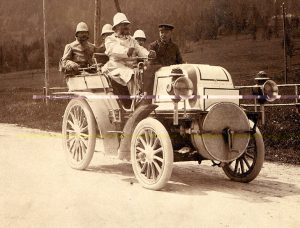

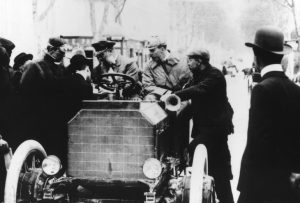

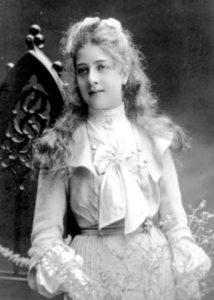
You must be logged in to post a comment.